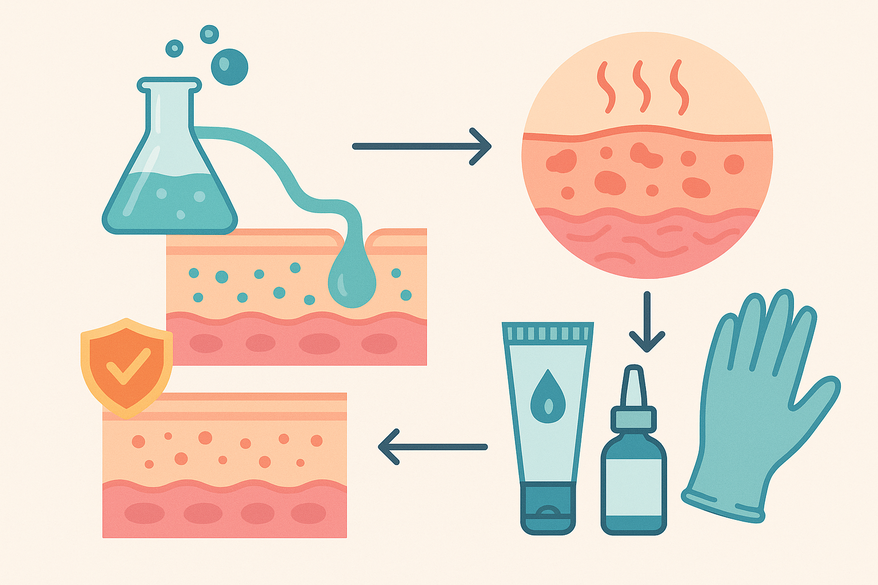Understanding Irritant Contact Dermatitis from Chemicals: Causes, Symptoms & Prevention
Discover how irritant contact dermatitis from chemicals develops, its symptoms, treatment options, and prevention strategies to protect your skin.

Estimated reading time: 6 minutes
Key Takeaways
- Irritant contact dermatitis from chemicals is a non–immune mediated skin inflammation caused by direct injury to the epidermis.
- It differs from allergic contact dermatitis by *not* requiring prior sensitization or T-cell involvement.
- Chemical irritants such as surfactants, strong acids/bases, and industrial agents strip lipids and denature proteins in the skin barrier.
- Early signs include redness, swelling, burning and fissuring—keeping a symptom diary helps identify triggers quickly.
- Diagnosis is based on exposure history, lesion distribution, and exclusion of allergic causes through patch testing.
- Treatment focuses on irritant removal, barrier repair with ceramide-rich emollients, and short-course topical corticosteroids.
- Prevention strategies include product substitution, proper PPE, barrier creams, and following Safety Data Sheets (SDS).
Table of Contents
- What Is Irritant Contact Dermatitis from Chemicals?
- How Chemicals Cause Irritant Contact Dermatitis
- Signs and Symptoms of Irritant Contact Dermatitis from Chemicals
- Diagnosis and Medical Considerations
- Treatment Options for Irritant Contact Dermatitis from Chemicals
- Prevention Strategies for Irritant Contact Dermatitis from Chemicals
- Conclusion
- Additional Resources
What Is Irritant Contact Dermatitis from Chemicals?
Keyword: irritant contact dermatitis from chemicals
Irritant contact dermatitis from chemicals is an inflammatory reaction caused by direct cytotoxic effects on the skin’s outer layer. Unlike allergic contact dermatitis, which is *immune-mediated*, this condition arises from physical or chemical damage to the epidermal barrier. The injury may occur on first exposure if the irritant is sufficiently strong.
How Chemicals Cause Irritant Contact Dermatitis
Keyword: How Chemicals Cause Irritant Contact Dermatitis
Chemical irritants compromise the skin barrier through several mechanisms:
- Lipid stripping: Surfactants remove essential skin lipids.
- Protein denaturation: Strong acids or bases alter keratin structure.
- Increased TEWL: Transepidermal water loss allows deeper irritant penetration.
Signs and Symptoms of Irritant Contact Dermatitis from Chemicals
Keyword: Signs and Symptoms of Irritant Contact Dermatitis from Chemicals
Early recognition is key. Look for:
- Redness and swelling
- Burning or stinging sensations
- Pain and fissuring
- Dry, scaly patches
Maintain a *symptom diary* to correlate flare-ups with specific exposures.
Diagnosis and Medical Considerations
Keyword: Diagnosis and Medical Considerations
The diagnostic approach includes:
- Detailed exposure history
- Distribution matching to contact areas
- Patch testing to rule out allergic dermatitis
- Photopatch testing or biopsy in complex cases
For an AI-assisted at-home overview, upload images to Rash Detector, an AI-powered skin analysis app, and receive an instant sample report.

Treatment Options for Irritant Contact Dermatitis from Chemicals
Keyword: Treatment Options for Irritant Contact Dermatitis from Chemicals
- Irritant removal: Discontinue or rinse away the offending agent immediately.
- Barrier repair: Use ceramide-rich emollients to restore lipid layers.
- Topical corticosteroids: Short courses reduce inflammation.
- Oral agents: Prescribed for severe or widespread flares.
Prevention Strategies for Irritant Contact Dermatitis from Chemicals
Keyword: Prevention Strategies for Irritant Contact Dermatitis from Chemicals
- Avoidance & Substitution: Read labels and SDS—replace harsh cleaners with pH-balanced alternatives.
- PPE & Safe Handling: Wear nitrile gloves, aprons, and face shields; follow proper dilution and ventilation guidelines.
- Barrier Reinforcement: Apply moisturizer after handwashing and consider overnight occlusion with cotton gloves.
For workplace-focused approaches, see work-related skin rash prevention and occupational dermatitis management guide. For home-based chemical exposures, refer to household chemical dermatitis guide.
Conclusion
Irritant contact dermatitis from chemicals is a non-immune mediated condition resulting from direct epidermal injury. *Vigilance*, early intervention, and consistent barrier care are essential to minimize risk and control flare-ups. By making informed product choices and using proper protective measures, you can keep your skin healthy and resilient.
Have you experienced workplace or household dermatitis? Share your questions or tips in the comments below.
Additional Resources
- National Eczema Association – Contact Dermatitis overview
- NHS – Contact Dermatitis causes & prevention
- American Academy of Family Physicians – Clinical review
- Johns Hopkins Medicine – Contact Dermatitis facts
FAQ
- What is the main difference between irritant and allergic contact dermatitis?
Irritant dermatitis is caused by direct chemical injury without prior sensitization, whereas allergic dermatitis is an immune response requiring sensitization to an allergen. - How soon do symptoms appear after exposure?
Symptoms can appear within minutes to hours, depending on irritant strength and skin condition. - When should I seek medical attention?
Consult a healthcare provider if symptoms worsen despite home care, spread beyond the contact area, or if you experience severe pain or infection signs. - Can barrier creams prevent dermatitis completely?
Barrier creams reduce risk but should be combined with PPE, safe handling practices, and product substitution for best protection.





